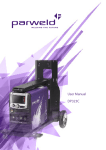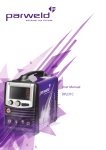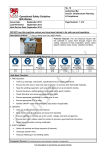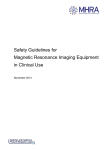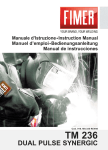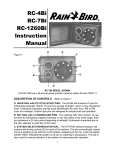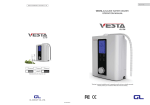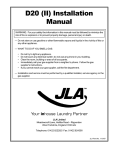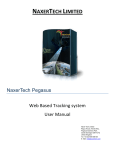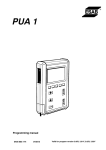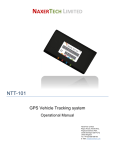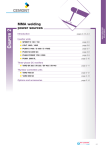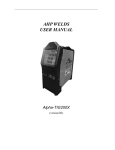Download User Manual DP403SW DP503SW - Wholesaleweldingsupplies.ie
Transcript
User Manual DP403SW DP503SW ISSUE 2 USER AND MAIINTENANCE MANUAL Parweld would like to thank you for choosing this machine; if used according to the instructions reported in this user and maintenance manual, it will accompany you in your work for many years without any problems. This manual is an integral part of the machine and must accompany it whenever moved or resold. The user is responsible for making sure the machine is complete and in good working order. The manufacturer has the right to make changes at any time, without notice. No part of this manual may be translated into another language, adapted or reproduced with any means (including scanned documents, photocopies, film and microfilm) without the prior written consent of the manufacturer INDEX • CAUTION ......................................................................................... NOMINAL DATA ..................................................................................................... 1. GENERAL SPECIFICATIONS AND NOTES FOR CONSULTING THIS MANUAL ............................................................................................... 2. DESCRIPTION OF THE EQUIPMENT .......................................................... 3. LOADING THE WELDING WIRE................................................................... 4. MIG/MAG WELDING...................................................................................... 4. 1 Manual Short Arc MIG Welding ................................................................... 4. 2 Synergic Short Arc MIG WELDING ............................................................ 4. 3 Pulse synergic MIG WELDING ................................................................... 5. MIG WELDING CONECTOR.......................................................................... 5. 2 CONNECTOR FOR MIG WELDING with a traditional torch....................... 5. 3 CONNECTOR FOR MIG WELDING with a Spool or Push-Pull torch ...... 6. STRIKING AN ARC IN MIG WELDING.......................................................... 7. ADJUSTING THE WELDER........................................................................... 8. HOW TO ACHIEVE THE BEST WELDING RESULTS.................................. 9. MMA WELDING.............................................................................................. 9. 1 MMA WELDING Manual ............................................................................... 10 WELDING TABLE.......................................................................................... 11 CONNECTION FOR MMA WELDING............................................................ 12. IGNITING THE MMA ARC ............................................................................. 13. TIG WELDING................................................................................................ 13. 1 TIG WELDING (Lift-Arc) ............................................................................... 14. CONNECTOR FOR TIG WELDING ............................................................. 15. IGNITION OF THE TIG ARC.......................................................................... 16. POWER CONNECTOR.................................................................................. 17. REMOTE CONNECTION ............................................................................... 17.1 REMOTE CONTROL OF THE WELDING CURRENT ................................... 18. CONNECTING THE OUTPUTS .................................................................... 19. CONNECTING THE GAS CYLINDER AND THE GAS REGULATOR 20. ORDINARY MACHINE MAINTENANCE........................................................ 22. MEMORISING THE WORK POINT................................................................ 23. LOCKING A WORK POINT............................................................................ 24. TROUBLESHOOTING ................................................................................... 25. BLOCK DIAGRAM WIRE FEEDER............................................................... 26. BLOCK DIAGRAM GENERATOR.................................................................. 27. SPARE PARTS DP403SW........................ .................................................... 28. SPARE PARTS DP503SW............. ............................................................... 29. SPARE PARTS WIRE FEEDER .................................................................... page. 2, 3, 4 page 5 page 6 page. 6 page. 9 page. 10 page. 10 page. 11 page. 13 page. 14 page. 15 page. 15 page. 15 page. 15 page. 15 page. 16 page. 16 page. 17 page. 17 page. 17 page. 18 page. 18 page. 19 page. 19 page. 20 page. 20 page. 20 page. 20 page. 20 page. 21 page. 21 page. 21 page. 24 page. 25 page. 25 page. 26 page. 27 page. 28 CONTENTS 2 3 www.parweld.com 4 www.parweld.com DP353 5 www.parweld.com DP403SW DP503SW 1. GENERAL SPECIFICATIONS AND NOTES FOR CONSULTING THIS MANUAL The DP403SW, and DP 503SW welders are made using INVERTER technology. They are extremely compact and versatile devices that can be used in all those situations that require minimum obstruction, combined with the highest performance. These welders use both manual and synergic MMA, TIG and MIG/MAG (short arc, pulse or double pulse). The innovative operator interface system, which uses a large 5,7” TFT colour screen, allows for simple and intuitive use of the equipment, without renouncing on the possibility to personalise all of the welding settings. All of the main parameters of the machine are stored on a memory card (SD-Card), keeping the equipment constantly up-dated with the latest welding developments. If the memory card is removed the equipment will cease to function, providing an optimal antitheft system and safeguard against inappropriate use. Thanks to the advanced control techniques adopted, the product is extremely reliable and easy to use. This instruction manual provides detailed ONLY FOR DP503 information on the machine settings: reading the entire manual will allow you to appreciate the extreme flexibility and practicality of use. Caution: the device must only be used in the manner and for the purpose described in this manual. Never use inappropriately or for any other purpose. 6 www.parweld.com 1. Graphic display: The 5,7’’ colour screen displays different screens, according to the welding mode or settings. In weld mode the display is divided into five principal: Part 1: Machine status Part 2: Meaning of the active buttons (buttons 2, 3, 4, 5,6 di fig.1) Part 3: Size values set Part 4: Type of process selected Part 5: Indicates the values that can be set for the various welding settings (to change the values select using switch 10 and confirm the selection by pressing the same switch; the value will be highlighted in a contrasting colour. The values can be changed by turning the switch, to confirm the new value press the switch again. 10). Highlighted value: Indicates the parameter that is being changed using switch 10. DISPLAYS: - When the screen comes on, the Parweld logo will appear and the Firmware revisions will load. CONTROL BUTTONS: (2, 3, 4, 5,6 in fig.1) Each control button is associated with a specific function shown on the display. 7. SD slot: this slot, covered with a rubber cap, contains the SD-Card provided with the machine; without the card, the machine will be inactive and a warning message will appear on the screen. 7 www.parweld.com 8. USB port: for technical assistance only. 9. Switch for adjusting the principal welding settings: This switch is used to set the principal welding parameters: MMA/TIG Welding; set the welding current 11. H²O in: to be used only with liquid cooling torches. 12. H²O out: to be used only with liquid cooling torches. 13. Connector for remote control. 14. “+” dinse front connector: positive pole inlet. MMA Mode: Electrode holder 15. EUROCONNECTOR (SEPARATED TROLLEY): quick connector for welding torch. This connector is used to supply welding gas to the torch, the electrical contacts of the torch button and the welding current. 16. ON-OFF switch: turns the machine on and off. DP503SW machine is equipped by hydromagnetic for this purpose, as showed in pic. 16 17. “-” dinse front connector: negative pole inlet. MMA Mode: Ground clamp TIG Mode: TIG torch MIG Mode with gas: Not used MIG without gas mode: Not used 18. “+” dinse front connector: positive pole inlet. MMA Mode: Electrode holder MIG Mode: Ground clamp MIG with gas mode: Not used MIG without gas mode: Not used 19. TIG gas Outlet 20. MIG signal connector: Connection of the signals to the push-pull torch 21. Filling cap of the cooling liquid (Optional) (Cooling unit) 22. H²O in: To be used only with liquid cooling torches. 23. AIR GRILL 24. ON-OFF switch and light of the control unit (Option): This lights up when the cooling system is fed. 24. ON-OFF switch and light of the control unit (Option): This lights up when the cooling system is fed. which are necessary for CAN-BUS operation using the connection with the generator connector (35). 27. “+” REAR DINSE CONNECTOR: positive pole inlet. (Cable bundle) (Separate trolley). Exchanges signals with the generator, which are necessary for operating the machine via the connection with the DINSE connector (31) 28. CONNECTION OF LIQUID COOLING TUBES (Cable bundle) (Separate trolley): to be connected directly to the control unit. (40) 29. FUSE OF THE POWER SUPPLY UNIT 30. Black gas connector (Cable bundle) (Separate trolley). Exchanges the signals with the generator, which are necessary for discharging the gas through the connection with the respective connector (37). 3 1 .POSITIVE DINSE CONNECTOR (Generator) 32. INPUT CABLE: Connect to the mains power supply. 33. GAS TUBE CONNECTOR: Must be connected to the pressure reducer of the gas cylinder. 35. CAN: Programming connector. 36. CONNECTOR OF THE POWER SUPPLY UNIT 37.Black gas connector (Cable bundle) (Generator). 38. Signal connector (Cable bundle) (Generator) 39. Cable for supplying power to the liquid cooling system (Optional cooling unit) 40. CONNECTION OF LIQUID COOLING TUBES 25. Signal connector. (Cable bundle) (Separate trolley): Exchanges signals with the generator, which are necessary for operating the machine via the connection with the signal connector (38) 26. CAN (Cable bundle) (Separate trolley): Programming connector. Exchanges signals with the generator, 41. WIRE SPOOL SUPPORT 42. WIRE FEEDER SYSTEM: see figure 3A for a more detailed image. 43. INLET OF THE WIRE FEEDER MOTOR 44. WIRE TENSION REGULATOR: Adjusts the tension of the welding wire. 45. WIREFEEDER SPOOLS 8 www.parweld.com 3. LOADING THE WELDING WIRE To load the welding wire, follow these instructions carefully, in the order described below. Warning: before inserting the wire, always remove the gas nozzle (Fig. 4A) and the wire feeder tip (Fig. 4B) from the welding torch. 1. Disconnect the cable from the power supply (32 of Fig. 2). Caution: before proceeding with the next step, make sure Tighten or loosen the hex socket to set the correct tension: tightening too much can cause excessive tension that could prevent the spool from turning correctly. On the other hand, if the tension is too loose, the welding wire could accidentally unwind. the torch cable (Fig. 4) is well extended and that the welding wire does not have any bends or burrs. Failure to follow these precautions could damage the wire-feeding tube inside the torch. Once the wire has been threaded through the torch, attach the wire-feeder tip and the gas nozzle. N.B. When changing the diameter of the wire, make sure that the correct cable of the wire-feeder spool is facing towards the inside of the machine. To do so, ensure that the diameter and type of wire is legible (facing towards the outside of the machine) Remember that the spools with a ‘V’ cable are suitable for feeding iron and steel wire. The spools with a ‘U’ are suitable for aluminium wire. 9 www.parweld.com 4. MIG/MAG WELDING To choose this welding mode use switch 10, select MIG and press confirm. MIG/MAG welding (Metal Inert Gas and Metal Active Gas) is continuous wire feed welding that provides a higher current density compared to welding with a fluxcovered electrode; this allows increased penetration and speed and the joint can be filled with less strokes. Welding is carried out by melting a metallic electrode, consisting of a continuous wire, in a welding pool at a constant speed, controlled by the welding torch. When the wire starts to feed, it touches the area that requires welding, creating an electric arc; the arc melts the wire, which is then deposited on the workpiece. 4.1 Manual Short Arc MIG Welding By turning switch 10 it is possible to choose from the different MIG-MAG welding modes; press the switch to select the desired option. Once selected the follow screen will appear: This welder can be used with the following types of wire: 1. Solid wire: must always be used with a gas shield. 2. Flux cored for gas welding: the centre of the wire contains a mineral product that improves the quality of the weld (this must always be used with gas). The correct method for connecting the torch and the earth cable can be seen in the table below: Switch 9 adjusts the machine power. There are three principal MIGMAG welding modes: 1.Manual short arc 2.Synergic short arc 3.Pulsed arc synergic Wire speed: This sets the speed of the welding wire. The welding current and the wire speed must be adjusted, taking into consideration the thickness of the workpiece. Larger pieces will require a higher wire speed. For best results, the wire speed must be adjusted during welding. 10 www.parweld.com soft-start: This adjusts the contact speed of the wire, creating a softer weld spark; the higher the level the lower the contact speed. Inductance: This adjusts the variation speed of the welding current for a sharper (low levels) or softer arc (high levels). 2t-4t-4Bi-level: This allows the user to set the 2 step or 4 step functions 2t: : In 2 step mode, the machine will weld for as long as the torch trigger is held down. 4t: In 4 step mode, one press of the torch trigger will start the welding process; press the button again and the welder will stop. 4Bi: NIn 4 step bi-level mode, one press of the torch trigger will start the welding process; successively, brief pressure on the trigger (for a duration of less than 1s) will make the welder pass from the welding current to the second level and vice versa. Pressing the torch trigger for lengthy periods of time will halt the welding process. Spot welding: This allows the user to set (when different to 0) the maximum welding duration in seconds. Pause: This allows the user to set (when different to 0) the duration of the pause between two successive tacks. Pre gas time: This allows the user to set the time of the gas supply, before feeding the welding current. Post gas time: This allows the user to set the time of the gas supply, when the welding current stops. Burnback: This allows the use to adjust the length of the wire at the end of the torch when the welding process ends. Hot start : This allows the user to set the welding ignition current to create a soft weld spark; this is generally used with the softstart setting. Water pump: This turns the water system ON or OFF, if present. 4.2 Synergic Short Arc MIG WELDING Synergic MIG welding allows the user to easily adjust the weld settings, according to the different materials that require welding. During synergic welding, switch 9 of Fig 1 simultaneously adjusts the tension or the speed of the wire. The other parameters are automatically adjusted to the set power, according to the diameter and type of wire selected. The percentage of the length of the arc can be varied using the ‘welding tension’ setting. Welding quality can be further improved by adjusting the ‘electronic inductance’ and ‘deposit’ settings. Turn switch 10 to choose from the different MIG-MAG welding options; press the switch again to confirm the chosen option. 11 www.parweld.com Settings that do not appear on the screen are accessible by turning switch 10. Once the type of wire has been selected (using switch 10), the settings page for the welding wire diameter will appear. Arc length: This changes the length of the electric weld arc with respect to the pre-set synergic values. Deposit: This modifies the deposit of the filler material (velocity of the wire) with respect to the pre-set synergic values. Inductance: This changes the variation speed of the welding current to achieve a sharper (low values) or softer arc (high values). Double short: This activates (ON) or deactivates (OFF) the two level option, i.e. the continuous switching between two different welding tension levels. L1 span: When the two level mode is active the duration of the first power level can be set. L2 span: When the two level mode is active the duration of the second power level can be set. L2 amplitude: When the two level mode is active the second power level (L2) can be set with respect to the set power (level L1). 2t-4t-4bilevel: This function adjusts the 2 step or 4 step settings. 2t: In 2 step mode, the machine will weld for as long as the torch trigger is pressed down. 4t: : In 4 step mode, press the trigger once to start the torch, press again to stop the torch. 4Bi: In 4 step Bi- Level mode, press the trigger once to start the torch, successively, briefly pressing the trigger (for less than 1s) will cause the set welding current to pass to second level and vice versa. Prolonged pressure on the torch trigger will halt the welding process. 2nd level: This option is for setting the values the wire speed, corresponding to the second power level, which is active when the values of the 2t-4t-4bi-level is set to 4bi. Initial/final current: it allows to switch up (ON) or down (OFF) mode with starting/final current. Initial current: allows setting the value at which the welding current is brought to immediately after the striking of the electric arc Initial time: allows setting the time of the current established by the Initial Current parameter. In 4t/4bi mode this time is irrelevant and the initial current is kept for as long as the torch button is held down. Ramp ls- > l1: allows setting the duration of the upslope of the welding current. Ramp l1- > lf: allows setting the duration of the downslope of the welding current Final current: allows setting the value at which the welding current is brought to on completion of the downslope Final time: allows setting the time of the current established by the Final Current parameter. In 4t/4bi mode, this time is irrelevant and the final current is kept for as long as the torch button is held down. Spot welding: This sets the maximum welding duration (when different to 0), in seconds. Pause: This sets the duration of the pauses (when different to 0), between two successive tacks. Pre gas time: This sets the gas supply time before the welding current is supplied. Post gas time: This sets the gas supply time after the welding current supply ends. 12 www.parweld.com Burnback: This adjusts the length of the wire in the tip of the torch, when the welding process comes to an end. Soft-start: this adjusts the contact speed of the wire, to obtain a soft weld spark; the higher the values the lower the contact speed. Hot-start: This sets the weld ignition current, in order to achieve a softer weld spark; this is generally used with the soft-start option. Water pump: When present, this turns the water system ON or OFF. Once the type of wire has been selected (using switch 10), the settings page for the welding wire diameter will appear. The wire’s diameters could not be available for all models. 4.3 Pulse synergic MIG WELDING Pulse synergic MIG welding allows obtaining a relatively cold welding bead and good penetration. The low energy input makes this welding process particularly suitable for thin layers and for materials such as stainless steel and aluminium. During welding with synergic adjustment, the wire speed (i.e. welding power) can be adjusted with knob 9 shown in Fig.1. The other parameters are automatically adjusted to the set power depending on the type and diameter of the wire selected. By turning switch 10 it is possible to choose from the different MIG-MAG welding modes; press the switch to select the desired option. Once selected, the screen with the welding wire material options will appear Arc length: This changes the length of the electric weld arc with respect to the pre-set synergic values. Deposit: This modifies the deposit of the filler material (velocity of the wire) with respect to the pre-set synergic values. Double pulse: This activates (ON) or deactivates (OFF) the two level option, i.e. the continuous switching between two different welding tension levels. 13 www.parweld.com L1 span: When the two level mode is active the duration of the first power level can be set. L2 span: When the two level mode is active the duration of the second power level can be set. L2 amplitude: When the two level mode is active the second power level (L2) can be set with respect to the set power (level L1). 2s-4s-4Bilevel: This function adjusts the 2 step or 4 step settings. 2s: In 2 step mode, the machine will weld for as long as the torch trigger is pressed down. 4s: : In 4 step mode, press the trigger once to start the torch, press again to stop the torch. 4Bi: In 4 step Bi- Level mode, press the trigger once to start the torch, successively, briefly pressing the trigger (for less than 1s) will cause the set welding current to pass to second level and vice versa. Prolonged pressure on the torch trigger will halt the welding process. 2nd level: This option is for setting the values the wire speed, corresponding to the second power level, which is active when the values of the 2t-4t-4bi-level is set to 4bi. Initial/final current: it allows to switch up (ON) or down (OFF) mode with starting/final current. Initial current: it allows to set the value at which it carries the welding current mode 4t/4bi after that time the ignition of the electric arc. Initial time: it allows to set the time that is applied to the current set by parameter Initial current. In this mode 4t/4bi time is irrelevant and the initial current is maintained as long as the trigger is held down. Ramp ls- > l1: it allows to to set the duration of the ramp-up of the welding current. Ramp l1- > lf: it allows to set the duration of the ramp down of the welding current. Final current: it allows to set the value at which it carries the welding current to the completion of the ramp-down. Final time: it allows to set the time that is applied to the current parameter set by the current final. In this mode 4t/4bi time is irrelevant and the final current is maintained as long as the trigger is held down. Spot welding: This sets the maximum welding duration (when different to 0), in seconds. Pause: This sets the duration of the pauses (when different to 0), between two successive tacks. Pre gas time: This sets the gas supply time before the welding current is supplied. Post gas time: This sets the gas supply time after the welding current supply ends. Burnback: This adjusts the length of the wire in the tip of the torch, when the welding process comes to an end. Soft-start: this adjusts the contact speed of the wire, to obtain a soft weld spark; the higher the values the lower the contact speed. Hot-start: This sets the weld ignition current, in order to achieve a softer weld spark; this is generally used with the soft-start option. Inductance: This changes the variation speed of the welding current to achieve a sharper (low values) or softer arc (high values). Water pump: When present, this turns the water system ON or OFF. Please refer to the following table for the correct welding current settings: 5. MIG WELDING CONECTOR The connector for the welding cables comes with a quick connect system that uses appropriate connectors. 5.2 CONNECTOR FOR MIG WELDING with a traditional torch 1) Connect the earth cable to the appropriate ‘- ‘ socket on the front of the device (17 of Fig 1). Insert the connector by lining up the key with the groove and turn in a clockwise direction until it stops. Do not fasten too tightly! 2) Connect the torch to the appropriate socket in the front of the device (15 di Fig 1), turning the connector in a clockwise direction until it stops. Do not fasten too tightly! Warning: the machine is provided with sockets for the MIG welding torch (Fig 4) This accessory has a long life-time if periodical controls of the gas nozzle and the wirefeeder tip are carried out (Fig 4A) (Fig 4B). These parts must be kept well-cleaned and intact. Replace the wire guide when the wire no longer threads correctly. www.parweld.com 14 5.3 CONNECTOR FOR MIG WELDING with a Spool or Push-Pull torch 1) Connect the earth cable to the appropriate ‘- ‘ socket. (17 of figure 1). Insert by lining up the key with the groove and turn in a clockwise direction until it stops. Do not fasten too tightly! 2) Connect the torch to the appropriate socket on the front of the device (15 of Fig 1), turning in a clockwise direction until it stops. Do not fasten too tightly! 3) Insert the connector of the torch into the appropriate female socket. MIG WELDING: Connect the pressure regulator to the cylinder, after which attach the gas tube of the torch to the latter. MIG welding is usually carried out with a constant current, with a positive pole (“+ “see fig.5). The MIG torch cable is connected to the Euroconnector (15 of fig.1), whilst the earth cable of the workpiece is connected to the ‘-‘ socket on the front (17 di fig.1). At this stage adjust the welding current using the potentiometer (9 of Fig.1), situated on the front panel. The diameter of the electrode and the welding current settings must be selected according to the thickness of the workpiece. 6. STRIKING AN ARC IN MIG WELDING The MIG-MAG welding process is when an electric arc is created between a consumable wire and the workpiece, protected within a gas atmosphere. This atmosphere can be either inert (Argon) or active (CO2 or a mixture of Argon and CO2). The wire is continuously fed through a torch by a wire feeder to the weld pool. A solid wire or flux-cored wire can be used. The transfer methods of the filler material define different arc types: 15 www.parweld.com SHORT ARC (short-circuit transfer): this brings the electrode into direct contact with the weld pool, which creates a short-circuit that extinguishes the arc, after which the arc reignites and the cycle is repeated. SPRAY ARC (spray transfer): this allows the droplets to detach from the tip of the electrode, which successively reach the weld pool. The fact the arc is visible, reduces the need for the operator to strictly observe the adjustment tables, allowing for direct control of the welding pool. - the tension directly influences the appearance of the welding seam, but the dimensions of the welding surface can be varied, according to requirements, by manual movement of the torch to obtain variable deposits with a constant tension. - the speed of the movement of the wire is in relation to the welding current. 7. ADJUSTING THE WELDER Once the welding tension has been set, maintain the length of the electric arc between 5 and 10 mm and adjust the wire speed to achieve the best welding results. Initially, carry out a welding test on a well-cleaned sample, free of any coating, rust or paint. NOTE The torch trigger controls the following functions: - gas flow - wire movement - welding current 8. HOW TO ACHIEVE THE BEST WELDING RESULTS 1. Hold the torch at an angle of 45° from the workpiece. Keep the gas nozzle (Fig. 4A) at a distance of approximately 6 mm from the workpiece. 2. Move the torch with a continuous movement, using a push, not pull, motion. This will guarantee the gaseous shield of the arc. 3. Avoid welding in high winds. If the wind is too strong it could carry the gas away from the welding pool, creating a porous (weak) weld. 4. Keep the wire clean: never use rusty wire. 5. Make sure the torch cable is free of dents or coils, which could compromise the correct movement of the wire. 6. When changing the wire spool, always clean the wire feed tube with compressed air 9. MMA WELDING To select this welding mode, use switch 10, select MMA and press confirm. Electric arc welding with a covered MMA (Metal Manual Arc) electrode or SMAW (Shielded Metal Arc Welding) is a manual welding procedure that takes advantage of the heat generated by the electric arc, which strikes between a covered earthed electrode and the workpiece. This procedure allows for the creation of joints in any position, in the workshop, outdoors, in confined areas or places that are difficult to access. With the DP403SW and DP503SW it is possible to weld any type of electrode and diameter. The spark of the arc occurs by placing the electrode close to the workpiece. The correct connection of the electrode clamp holder and the earth cable can be seen in the table below: Always make sure that the earth and the electrode clamp holder are kept far apart. 9.1 MMA WELDING Manual This mode can be accessed using switch 10. Selecting this option will take you to the welding screen: Switch 9 in fig. 1 adjusts the welding current (very thick workpieces require a higher current). Furthermore, switch 10 adjusts the parameters shown in the figure below: Arc Force: This sets the current increase ratio in relation to the welding current, that the welder can force, in order to keep the arc appropriately ignited in any position. Hot Start: This sets the current increase ratio in relation to the welding current, that the welder can force when the arc is ignited, to improve the quality of the same. Hot start span: This sets the time period when the jot start current is forced. Remote: This switches the remote control (which connects to socket 13 of fig.1) of the current intensity ON or OFF. 16 www.parweld.com 10. WELDING TABLE Use the table below to calculate the welding current, according to the type of electrode used: 11. CONNECTION FOR MMA WELDING The Dinse connector is inserted by lining-up the key with the groove and turning the connector in a clockwise direction until it stops. The electrode clamp holder and earth must be connected to the ‘+’ and ‘-‘ terminals, according to the specifications of the electrodes used. 11. CONNECTION FOR MMA WELDING The Dinse connector is inserted by lining-up the key with the groove and turning the connector in a clockwise direction until it stops. The electrode clamp holder and earth must be connected to the ‘+’ and ‘-‘ terminals, according to the specifications of the electrodes used. 17 www.parweld.com This is carried out by stopping a while over the last crater (i.e. the end of the welding seam), returning slowly on the previously deposited seam for approximately two centimetres and, only at this point, moving the electrode away from the workpiece to turn off the arc. 13. TIG WELDING To select this welding mode : turn switch 10, select TIG and press confirm. Inert gas (Argon) welding with an infusible Tungsten electrode and arc (often call TIG (Tungsten Inert Gas) for short, is a welding procedure whereby the heat is produced by an arc that strikes between a tungsten electrode (which is not consumable) and the workpiece. The welding is carried out by fusing the edges of the workpiece or by adding other filler material using specific types of rod to create a joint. The torch is ignited by touching the workpiece with the electrode and then lifting. The TIG procedure can be adapted to any work position and can also be applied to very thin sheets of metal (0,2-0,3 mm). The TIG procedure is distinguished by the ease with which the arc can be controlled, a powerful and concentrated thermal source and the simple manner in which the filler material can be controlled. This makes the TIG procedure particularly suitable for precision welding on a wide variety of thicknesses, in difficult positions and on pipes which require full penetration. The TIG procedure can be used on various types of metals, such as, ferrous materials, alloys, nickel, copper, titanium, magnesium. During welding, potentiometer 9 in fig. 1, for example, regulates the welding current. The correct connection of the torch and earth cable is shown in the following table: 13.1 TIG WELDING (Lift-Arc) Button 9 controls the current and the machine power. Select this option and the welding screen will appear: Make sure that the pulse setting is switched off. If not, use the menu and set the option PULSE to OFF, as shown in the above figure. During welding it is possible to adjust the current using button 9 in fig. 1. Both the welding current values and the relative arc tension used will be displayed continually on the screen. ADJUSTMENTS AND SETTINGS: Button 10 adjusts the welding settings on the screen: prolonged pressure on the torch trigger will stop the welding process. 2t-4t-4bilevel: This function sets the 2 tempi or 4 tempi mode. 2t: In 2 tempi mode, the machine welds for the entire time the torch trigger is pressed down. 4t: In 4 step mode, pressing the torch trigger once starts the welding process; press the button again to stop welding 18 www.parweld.com 4Bi: In 4 step Bi-Level mode, press the torch trigger once to start welding. Successively, brief pressure on the trigger (less than 1s) makes the set welding current pass to the second level (I 2nd level) and vice versa. Prolonged pressure on the torch trigger will halt the welding process. 2nd level current: When the 4Bi mode of the 2/4 settings is selected, the 2nd level current can be set according to the percentage of the welding current. start current: This sets the values of the welding current settings required after the ignition of the electric arc. start time: This sets the time period of the current established in the initial current settings. slope up: This sets the upslope of the welding current. slope down: This sets the duration of the downslope time of the welding current. end current: this sets the values of the welding current on completion of the downslope. end time: This sets the time period when the current established in the end current settings is applied. post gas time: This sets the gas supply time at the end of the supply of the welding current. pulse mode: This allows for the activation (ON) or deactivation (OFF) of the pulse welding mode; when the pulse welding mode is active, for a certain period of time, the machine will supply the welding current and for another period of time the current defined in the I background settings will be supplied. The number of current pulses for a set period of time are based on the values of the frequency settings. background current: This sets the base current used during pulse mode. pulse frequency: This sets the pulse frequency when pulse welding mode is active. pulse balance: When pulse welding mode is active, this sets the ratio between the time the welding current and the base current is applied. water pump: Where present, this turns the water system ON or OFF. remote: This turns the remote control of the current intensity supplied ON or OFF. spot welding: This sets the maximum welding duration (if different to 0), in seconds. 19 www.parweld.com 14. CONNECTOR FOR TIG WELDING 1) Connect the earth cable to the appropriate ‘+’ socket on the front of the device (18 of fig 1). Insert by lining-up the key with the groove and turn in a clockwise direction until it stops. Do not fasten too tightly! 2) Connect the torch to the appropriate ‘-‘ socket on the front of the device (17 of fig 1). 3) Insert by lining-up the key with the groove and turn in a clockwise direction until it stops. Do not fasten too tightly! 4) Insert the torch pulse signal connector into the socket (part 2 of the display); TIG WELDING: Before connecting the gas make sure the cylinder contains pure Argon gas. Never use any other type of gas. Connect the pressure regulator to the cylinder, after which, connect the latter to the gas tube of the torch. TIG welding is usually carried out with a constant current, with a negative pole (‘-‘ see fig.6). The cable of the TIG torch is then inserted into the negative socket (17 of fig.1), whilst the earth cable of the workpiece is connected to the positive socket. (18 of fig.1). At this stage it is possible to adjust the welding current using the potentiometer (9 of fig. 1) on the front panel. The diameter of the electrode and the welding current settings must be selected according to the thickness of the workpiece. 15. IGNITION OF THE TIG ARC Rest the ceramic of the TIG torch on the workpiece (step 1 of fig.7); bring the tungsten electrode into contact with the workpiece, then press the torch trigger, whilst moving in a circular motion where the ceramic is positioned (see step 2 of fig.7). Where: Sw is the torch trigger P is the potentiometer for controlling the current. At this stage, ignite the arc by moving the electrode away from the workpiece a few millimetres (step 3 of fig.7). Weld maintaining the same distance from the weld pool, whilst keeping the torch trigger held down. Release the button to interrupt the welding process. 16.POWER CONNECTOR Before connecting the machine check the tension, number of phases and the power supply frequency. The admissible power supply is indicated in the ‘Specific Techniques’ section on page 5 of this manual and on the information plate on the machine. Check that the earth of the welder has been connected correctly. Furthermore, make sure that the plug provided with the equipment is compatible with the local grid sockets. Make sure that the power supply provides sufficient power for the machine to function (tension ranges) The power supply grid protection devices to be used are listed in the ‘Specific techniques’ section of the present manual. 17.1 REMOTE CONTROL OF THE WELDING CURRENT With remote connector 20 in Fig. 1, it is possible to adjust the current near to the point where the welding is being carried out. To do so, it is necessary to create a connection with potentiometer P, shown in figure 8. The value of the potentiometer is not a critical factor: between 2.2kOhm and 10kOhm 1/2W can be used. Turn the potentiometer and select the welding current in a range between zero and the set value. 18. CONNECTING THE OUTPUTS Connection of the welding cables occurs via a Dinse quick-connect system with appropriate connectors 19. CONNECTING THE GAS CYLINDER AND THE GAS REGULATOR For TIG and MIG welding only. For MMA welding, skip this paragraph entirely. The machine is provided with a specific power cable that does not usually require an extension lead; in the event an extension lead is required, use one of the same capacity [Length/Cross section] or higher than the machine in use, according to the length of the cable. A 2.5 mm² three-pole cable + earth, of the same size or larger. 17. REMOTE CONNECTION Figure 8 shows the connections of the remote connector (20 of fig 1). 1. Connect the pressure regulator (2) to the cylinder (3). Make sure the regulator is suitable for the cylinder pressure. Attach the connector nut (6) of the regulator (2) to the cylinder (3). (Do not screw too tightly; excessive force could damage the valve (1) of the cylinder (3).) 2. Connect the gas tube (4) to the regulator (2) and secure with a cable tie (5). 3. Make sure that the gas tube is connected to the welder correctly. 4. Open the valve (1) of the cylinder (3). Press the torch trigger and check the gas is flowing correctly. To carry out this operation release the clutch of the motor. 20 www.parweld.com Warning: Cylinders contain high-pressure gas; handle with extreme care. Inappropriate handling and use could cause serious accidents. Never stack the cylinders or expose to excessive heat, flames or sparks. Do not bash the cylinders together. Contact your supplier for further information on the use and maintenance of the cylinders. Warning: Never use damaged cylinders: in this case, advise your supplier immediately. 20. ORDINARY MACHINE MAINTENANCE Every three months periodically remove dust from the suction nozzle using compressed air. Always direct the air from the inside towards the outside of the machine to avoid blowing dirt inside the welder. When carrying out this operation, always make sure the machine is not connected to the power supply 22. MEMORISING THE WORK POINT As illustrated in the previous paragraphs, the welder allows for a notable personalisation of the work point (when used both manually and synergically). The work point for a workpiece can be saved in the memory and rapidly recalled at a later date. To save a work point follow the instructions below: 1. Select ready to weld on the display. 2. Set the appropriate parameters for the welding mode required. 3- Press the MEM+ button (4 of fig 1). 4- Turn switch 10 (fig 1), chose the first letter of the name with which you want to save the work point. 5- Press switch 10 to confirm the selected letter. 6Repeat steps 2 and 3 to complete the name. 7- Confirm the name by pressing the tick button again . From this moment onwards the work point will be memorised with its own name and displayed with the other welding procedures. Meaning of the back : SP button: cancels the previous letter inserted. Cancel: cancels the operation. OK: confirms the name of the work point. 23. LOCKING A WORK POINT The welder can lock the functions of switch 9 and 10, so that once a work point has been saved it cannot be changed, unless modified by a member of staff with a password, which can be defined at the discretion of the user. To proceed with locking a work point, it is necessary to first enter the necessary parameters for the required welding settings. Once this has been done, proceed as follows: 1. Press switch 9 of fig. 1 for approximately 5 seconds; the message in Fig. A will appear. After which, select button 1 of fig. A, with the name ‘Lock’ on the black and white display and lock symbol for the colour display. 2. You will then be asked to enter the password, which must be kept safe to make future modifications of the work point, should the need arise. 21 www.parweld.com Appendix: titles/button symbols/function buttons and pop-up notifications In the following figure and table, you will find the descriptions of the principal title/button symbols/ function buttons and pop-up notifications, with regard to error messages that may appear on the display: To enter the password, proceed as follows: 1- Turn switch 10 (fig 1) and select the first letter of the password. 2- To confirm the selection press switch 10. 3- Repeat steps 2 and 3 to complete the password. 4- Confirm by pressing the Tick switch again 3. Once the password has been confirmed the display will show the message in Fig. C, a lock symbol in the area 1 of the display and the functions Unlock and Reset pw (reset password) which correspond to buttons 2 and 3 (fig. 1) respectively, in area 2 of the display; 4. To exit the lock option of the work stage, briefly press switch 9 in fig. 1; 5. Should the need to modify the work stage arise, activate the ‘Unlock’ option by pressing the function button. The unlock function will require the user to enter the password that was set and activated as described above. 6. The reset password option can be activated by pressing the (Reset pw) button. WARNING: The Reset Password option should only be used when there is no way of tracing the work stage and when the Lock/Unlock password has been lost. To use this function contact the Parweld technical support department directly. 22 www.parweld.com 23 www.parweld.com 24. TROUBLESHOOTING Below are a list of some of the most common problems that may arise, with the relative solutions. DEFECT CAUSE SOLUTION Machine switches off [display: off] [display: network error] Lack of tension on the supply grid. Refresh the power supply tension. Check supply grid. Refresh the power supply tension. The machine suddenly stops working after prolonged use [display: overheating or inverter overload] The machine has overheated due to excessive use and the thermal protection has intervened. Leave the machine to cool until the warning message disappears [display: inverter undervoltage] MMA: electrode in contact with the earth. MMA: electrode in contact with the earth. Arc off Poor contact between the earth clamp and the workpiece. Tighten the clamp and check again. Short circuit between the contact nozzle and the gas tube. Clean and replace contact nozzle and wire-feeder tip. Gas shield absent due to build-up of deposits in the gas nozzle. Clean any eventual deposits. Incorrect tilt angle of torch. The distance between the torch and the workpiece must be 5-10mm; the tilt angle must be no less than 60 degrees from the workpiece. Not enough gas Increase gas Damp workpiece Dry with a hot air pistol or other means. Welding arc is too long Shorten the arc fast torch movements Slow down torch movement Rusty material Clean Lateral incisions Welding speed is too high Reduce welding speed [display: no SD-card] The SD-card has been removed Insert SD-card Porous welding seam Scarce fusion 24 www.parweld.com 25 www.parweld.com 27 Spare Parts DP403SW 26 www.parweld.com 28 Spare Parts DP503SW 27 www.parweld.com 29 Spare Parts Wire Feeder 28 www.parweld.com EC declaration of conformity Hereby we declare that the machines as stated below Type: DP403SW DP503SW Conform to the EC Directives: 73/23/EEC and 89/336/EEC European standard: EN/IEC 60974-1 This is to certify that the tested sample is in conformity with all provisions of the above detailed EU directives and product standards. RoHS Compliance Declaration Directive 2002/95/ec of the European Parliament Restriction of use of certain hazardous substances in electrical and electronic equipment Type: DP403SW DP503SW The above listed products are certified to be compliant with the rohs directive with all homogeneous component parts being controlled to ensure material contents as per the list below. Cadmium 0.01% by weight Lead 0.1% by weight Mercury 0.1% by weight Hexavalent chromium 0.1% by weight Polybrominated biphenyl’s (pbbs) 0.1% by weight Polybrominated diphenyl ethers (pbdes) 0.1% by weight It should be noted that under specific exempted applications, where lead is used as an alloying element the following limits are applied in accordance with the regulations. Copper and copper alloy parts use less than 4% by weight of each homogeneous component. Steel and steel alloy parts use less than 4% by weight of each homogeneous component. Aluminium and aluminium alloy parts use less than 4% by weight of each homogeneous component. Only dispose off in authorised sites for electrical and electronic waste do not dispose of with general refuse or landfill waste. 29 www.parweld.com WEEE Statement WEEE (Waste Electrical & Electronic Equipment) 2002/96/EC In relation to implementing the legislation, Parweld has established relevant recycling and recovery methods. We have been fully compliant against the marking requirements since August 2005. Parweld is registered in the UK with the Environment agency as detailed below. For WEE compliance outside the UK please contact your supplier/Importer Parweld is registered with a compliance scheme Official registration number is WEE/FD0255QV When your equipment reaches the end of its service life you should return it to Parweld where it will be reconditioned or processed for recycling. Statement of warranty Limited Warranty: Parweld Ltd, hereafter, “Parweld” warrants its customers that its products will be free of defects in workmanship or material. Should any failure to conform to this warranty appear within the time period applicable to the Parweld products as stated below, Parweld shall, upon notification thereof and substantiation that the product has been stored, installed, operated, and maintained in accordance with Parweld’s specifications, instructions, recommendations and recognized standard industry practice, and not subject to misuse, repair, neglect, alteration, or accident, correct such defects by suitable repair or replacement, at Parweld’s sole option, of any components or parts of the product determined by Parweld to be defective. Parweld makes no other warranty, express or implied. This warranty is exclusive and in lieu of all others, including, but not limited to any warranty of merchantability or fitness for any particular purpose. Limitation of Liability: Parweld shall not under any circumstances be liable for special, indirect or consequential damages, such as, but not limited to, lost profits and business interruption. The remedies of the purchaser set forth herein are exclusive and the liability of Parweld with respect to any contract, or anything done in connection therewith such as the performance or breach thereof, or from the manufacture, sale, delivery, resale, or use of any goods covered by or furnished by Parweld whether arising out of contract, negligence, strict tort, or under any warranty, or otherwise, shall not, except as expressly provided herein, exceed the price of the goods upon which such liability is based. No employee, agent, or representative of Parweld is authorized to change this warranty in any way or grant any other warranty. Purchaser’s rights under this warranty are void if replacement parts or accessories are used which in Parweld’s sole judgement may impair the safety or performance of any Parweld product. Purchaser’s rights under this warranty are void if the product is sold to purchaser by non-authorized persons. 30 www.parweld.com Contact Your Local Distributor: Parweld Limited Bewdley Business Park Long Bank Bewdley Worcestershire England DY12 2TZ tel. +44 1299 266800 fax. +44 1299 266900 web: www.parweld.com email:[email protected] Parweld Limited Bewdley Business Park Long Bank Bewdley Worcestershire England DY12 2TZ tel. +44 1299 266800 fax. +44 1299 266900 www.parweld.com [email protected]
































